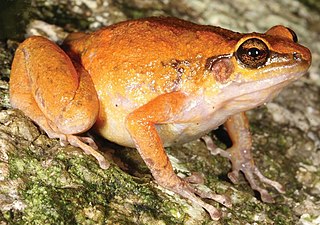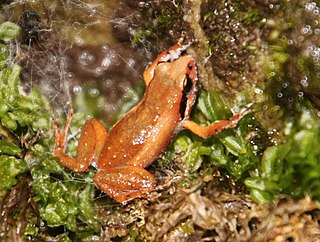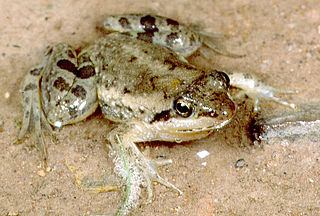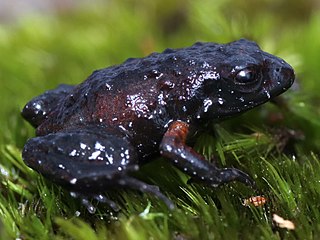Hyperolius jynx is a species of frog in the family Hyperoliidae. It is endemic to the Rumpi Hills in south-western Cameroon. The common name smooth egg-guarding frog has been proposed for this species.
Hyperolius microps is a species of frogs in the family Hyperoliidae. It is known with some certainty from northern Malawi, extreme northern Mozambique, Tanzania, and coastal Kenya; presumably its range extends into adjacent Zambia. However, its range and delimitation differs widely between sources.
Hyperolius bopeleti, also known as the Dizangue reed frog or Bopelet's reed frog, is a species of frog in the family Hyperoliidae. It is endemic to the coastal southwestern Cameroon. The specific name bopeleti honours M. Bopelet, a Cameroonian biologist.
Hyperolius igbettensis is a species of frog in the family Hyperoliidae. It is found in West Africa from Guinea eastward to Liberia, Ivory Coast, Ghana, Togo and Benin, Nigeria, and into Central Africa at least to Cameroon but likely further east to the Central African Republic and southwestern Chad; the eastern border of distribution of this species relative to other members in the Hyperolius nasutus complex is unclear. Common name Igbetti long reed frog has been coined for it. The type locality is near Igbetti, a village in Oyo State, Nigeria.

Hyperolius nasutus is a species of frog in the family Hyperoliidae. Common names include long-nosed reed frog, sharp-nosed reed frog and long reed frog. It is known from northern Angola and northern Botswana, but it presumably occurs more widely. The nominal Hyperolius nasutus was partitioned in 2013 into three cryptic species, the other two being Hyperolius viridis and Hyperolius microps. All these species are members of the so-called Hyperolius nasutus species group, the "long reed frogs".
Hyperolius schoutedeni is a species of frog in the family Hyperoliidae. It is known from the northern half of the Democratic Republic of the Congo, central-west and southeastern Republic of the Congo, and southeastern Gabon; its true range probably extends into the adjacent Central African Republic and South Sudan. It is morphologically very similar to Hyperolius cinnamomeoventris and has been confused with that species. However, molecular data suggests that its closest relatives include Hyperolius kivuensis, Hyperolius balfouri, and Hyperolius quinquevittatus, rather than H. cinnamomeoventris.

Leptopelis kivuensis is a species of frog in the family Arthroleptidae. It is found in the highlands of western Burundi, Rwanda, and Uganda, and in the extreme eastern Democratic Republic of the Congo. It has been considered synonym of Leptopelis karissimbensis, and has been confused with that species. Common names Kisenyi forest treefrog and Kivu tree frog have been coined for it.
Leptopelis oryi, also known as the Garamba forest treefrog and Ory's tree frog, is a species of frog in the family Arthroleptidae. It is found in the northeastern Democratic Republic of the Congo, northwestern Uganda, and adjacent South Sudan. It is morphologically similar to Leptopelis nordequatorialis from Cameroon, and has also been considered its synonym, but is currently treated as a distinct species. The specific name oryi honours Albert Ory, warden in the Garamba National Park, the type locality of this species.

Cophixalus zweifeli is a species of frog in the family Microhylidae. It is endemic to northern Queensland, Australia, and only known from the area of its type locality in the Cape Melville National Park. The species was named to honour American herpetologist Richard G. Zweifel. Common name Zweifel's frog has been coined for it. It is one of the five northeast Australian Cophixalus species that are specialized in boulder field habitats.

Arthroleptella is a genus of frogs known as moss frogs in the family Pyxicephalidae. The ten species of this genus are endemic to South Africa.
Phrynobatrachus irangi is a species of frog in the family Phrynobatrachidae. It is endemic to Kenya and is known only from two localities, its type locality, the eponymous Irangi Forest on the south-eastern slopes of Mount Kenya, and Kimande on the south-eastern slopes of the Aberdare Range. Common name Irangi puddle frog has been coined for it.

Phrynobatrachus perpalmatus is a species of frog in the family Phrynobatrachidae. It is found in the area stretching from the central and southern Sudan southward through South Sudan and central/eastern Democratic Republic of the Congo, extreme western Tanzania, Burundi, Malawi, and Zambia to northern Mozambique; its range might extend into northern Zimbabwe. Common names Lake Mwero river frog and webbed puddle frog have been proposed for it.

Amnirana lepus is a species of frog in the family Ranidae. It is found in Cameroon, Equatorial Guinea, Gabon, Central African Republic, Republic of the Congo, Democratic Republic of the Congo, and northern Angola. Common names Andersson's Cameroon frog, Andersson's white-lipped frog, and jumping white-lipped frog have been proposed for it.

Nanorana rarica is a frog species in the family Dicroglossidae. It is endemic to western Nepal. Its type locality is the eponymous Rara Lake located in the Rara National Park.
Ptychadena harenna is a species of frog in the family Ptychadenidae. It is endemic to Ethiopia and only known from its type locality at the foothills of the Bale Mountains, in the Bale Mountains National Park. The locality is within the Harenna Forest, and common name Harenna Forest grass frog has been coined for it.
Ptychadena wadei is a species of frog in the family Ptychadenidae. It is endemic to Ethiopia and only known from a small area southeast of Lake Tana, in the upper reaches of the Blue Nile. The specific name wadei honours Edward O.Z. Wade, an English illustrator and herpetology enthusiast who drew some of the illustrations accompanying the species description. Common name Wade's grass frog has been coined for it.
Odorrana junlianensis, also known as the Junlian odorous frog, is a species of frogs in the family Ranidae. It is found in southern China and in the northernmost Laos and Vietnam. Its type locality is the eponymous Junlian County in Sichuan.
Tomopterna ahli, commonly known as the Damaraland sand frog or Damara sand frog, is a species of frog in the family Pyxicephalidae. It is found in central to north-western Namibia and southwestern Angola.

Arthroleptella rugosa is a species of frog in the family Pyxicephalidae. It is endemic to South Africa and only known from the Klein Swartberg Mountain, an inselberg near Caledon, Western Cape. The specific name rugosa is Latin for wrinkled or rough and refers to the rough appearance of this species as well as its rough sounding advertisement call. Accordingly, the common name rough moss frog has been suggested for it.









